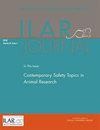Laboratory Safety, Biosecurity, and Responsible Animal Use.
IF 3.1
3区 农林科学
Q1 VETERINARY SCIENCES
引用次数: 8
Abstract
Research with animals presents a wide array of hazards, some of which overlap those in the in vitro research laboratory. The challenge for environmental health and safety professionals when making their recommendations and performing the risk assessment is to balance worker safety with animal safety/welfare. The care and husbandry of animals require procedures and tasks that create aerosols and involve metabolized chemicals and a variety of physical hazards that must be assessed in addition to the research related risks, all while balancing the biosecurity of the facility and NIH animal care requirements. Detailed communication between health and safety, research, and animal care teams is essential to understand how to mitigate the risks that are present and if modifications need to be made as the experiments and processes progress and change over time. Additionally, the backgrounds and education levels of the persons involved in animal research and husbandry can be quite broad; the training programs created need to reflect this. Active learning and hands-on training are extremely beneficial for all staff involved in this field. Certain areas of research, such as infectious disease research in high- and maximum-containment (biosafety level 3 and 4) facilities, present challenges that are not seen in lower containment or chemical exposure experiments. This paper reviews potential hazards and mitigation strategies and discusses unique challenges for safety at all biosafety levels.实验室安全,生物安全和负责任的动物使用。
对动物的研究呈现出一系列广泛的危险,其中一些与体外研究实验室的危险重叠。环境健康和安全专业人员在提出建议和进行风险评估时面临的挑战是平衡工人安全与动物安全/福利。动物的护理和饲养需要产生气溶胶的程序和任务,除了研究相关风险外,还需要评估代谢的化学物质和各种物理危害,同时平衡设施的生物安全和美国国立卫生研究院的动物护理要求。健康与安全、研究和动物护理团队之间的详细沟通对于了解如何减轻现有风险以及随着实验和过程的进展和变化是否需要进行修改至关重要。此外,从事动物研究和畜牧业的人员的背景和教育水平可能相当广泛;创建的培训计划需要反映这一点。积极的学习和实践培训对参与该领域的所有工作人员都非常有益。某些研究领域,如高和最高安全壳(生物安全等级3和4)设施中的传染病研究,带来了低安全壳或化学暴露实验所没有的挑战。本文回顾了潜在的危害和缓解策略,并讨论了所有生物安全级别的安全面临的独特挑战。
本文章由计算机程序翻译,如有差异,请以英文原文为准。
求助全文
约1分钟内获得全文
求助全文
来源期刊

Ilar Journal
农林科学-兽医学
CiteScore
5.10
自引率
20.00%
发文量
8
审稿时长
>18 weeks
期刊介绍:
The ILAR Journal is the peer-reviewed, theme-oriented publication of the Institute for Laboratory Animal Research (ILAR), which provides timely information for all who study, use, care for, and oversee the use of animals in research. The journal publishes original articles that review research on animals either as direct subjects or as surrogates for humans. According to policy, any previously unpublished animal research reported in the ILAR Journal will have been conducted according to the scientific, technical, and humanely appropriate guidelines current at the time the research was conducted in accordance with the Guide for the Care and Use of Laboratory Animals or other guidance provided by taxonomically-oriented professional societies (e.g., American Society of Mammalogy) as referenced in the Guide.
 求助内容:
求助内容: 应助结果提醒方式:
应助结果提醒方式:


